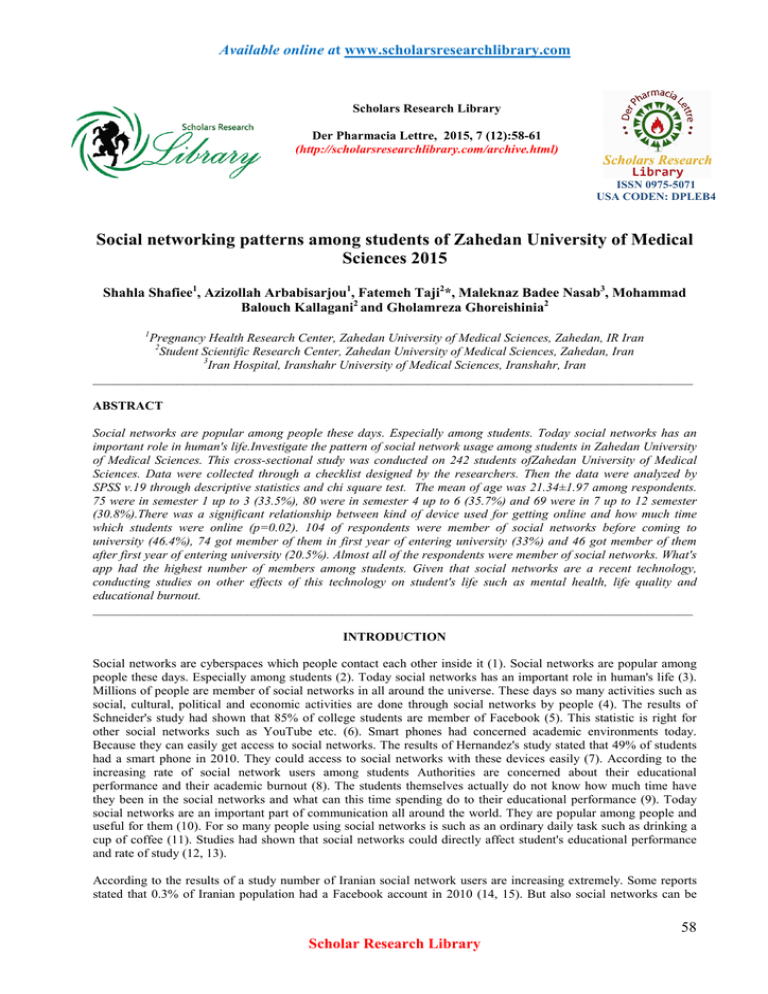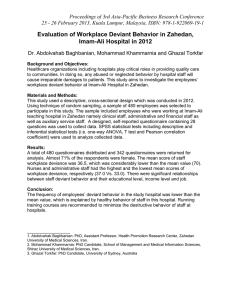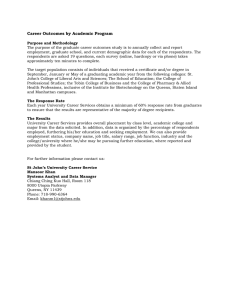Social networking patterns among students of Zahedan University of
advertisement

Available online at www.scholarsresearchlibrary.com Scholars Research Library Der Pharmacia Lettre, 2015, 7 (12):58-61 (http://scholarsresearchlibrary.com/archive.html) ISSN 0975-5071 USA CODEN: DPLEB4 Social networking patterns among students of Zahedan University of Medical Sciences 2015 Shahla Shafiee1, Azizollah Arbabisarjou1, Fatemeh Taji2*, Maleknaz Badee Nasab3, Mohammad Balouch Kallagani2 and Gholamreza Ghoreishinia2 1 Pregnancy Health Research Center, Zahedan University of Medical Sciences, Zahedan, IR Iran 2 Student Scientific Research Center, Zahedan University of Medical Sciences, Zahedan, Iran 3 Iran Hospital, Iranshahr University of Medical Sciences, Iranshahr, Iran _____________________________________________________________________________________________ ABSTRACT Social networks are popular among people these days. Especially among students. Today social networks has an important role in human's life.Investigate the pattern of social network usage among students in Zahedan University of Medical Sciences. This cross-sectional study was conducted on 242 students ofZahedan University of Medical Sciences. Data were collected through a checklist designed by the researchers. Then the data were analyzed by SPSS v.19 through descriptive statistics and chi square test. The mean of age was 21.34±1.97 among respondents. 75 were in semester 1 up to 3 (33.5%), 80 were in semester 4 up to 6 (35.7%) and 69 were in 7 up to 12 semester (30.8%).There was a significant relationship between kind of device used for getting online and how much time which students were online (p=0.02). 104 of respondents were member of social networks before coming to university (46.4%), 74 got member of them in first year of entering university (33%) and 46 got member of them after first year of entering university (20.5%). Almost all of the respondents were member of social networks. What's app had the highest number of members among students. Given that social networks are a recent technology, conducting studies on other effects of this technology on student's life such as mental health, life quality and educational burnout. _____________________________________________________________________________________________ INTRODUCTION Social networks are cyberspaces which people contact each other inside it (1). Social networks are popular among people these days. Especially among students (2). Today social networks has an important role in human's life (3). Millions of people are member of social networks in all around the universe. These days so many activities such as social, cultural, political and economic activities are done through social networks by people (4). The results of Schneider's study had shown that 85% of college students are member of Facebook (5). This statistic is right for other social networks such as YouTube etc. (6). Smart phones had concerned academic environments today. Because they can easily get access to social networks. The results of Hernandez's study stated that 49% of students had a smart phone in 2010. They could access to social networks with these devices easily (7). According to the increasing rate of social network users among students Authorities are concerned about their educational performance and their academic burnout (8). The students themselves actually do not know how much time have they been in the social networks and what can this time spending do to their educational performance (9). Today social networks are an important part of communication all around the world. They are popular among people and useful for them (10). For so many people using social networks is such as an ordinary daily task such as drinking a cup of coffee (11). Studies had shown that social networks could directly affect student's educational performance and rate of study (12, 13). According to the results of a study number of Iranian social network users are increasing extremely. Some reports stated that 0.3% of Iranian population had a Facebook account in 2010 (14, 15). But also social networks can be 58 Scholar Research Library Fatemeh Taji et al Der Pharmacia Lettre, 2015, 7 (12):58-61 ______________________________________________________________________________ useful in educational processes if we use them in a good way (16). People usually use them for communication with others (17), learning social rules (18), vacation and fun and using others experiences in different fields (19). Krishner and Karpinski had reported that Facebook users had a low GPA and studied their lessons less than other students (13).According to effects of social networking on student's educational performance and academic burnout we decided to conduct this study to investigate the pattern of social network usage among students in Zahedan University of Medical Sciences. MATERIALS AND METHODS This cross-sectional study was conducted on 242 students in Zahedan University of Medical Sciences. Data were collected through a checklist designed by the researcher. This checklist included 15 questions about times spent in social networks, time of getting member of social networks, type of social network etc. Validity of this checklist was approved by ten faculty members and expert panel at the university. Its reliability was calculated by Cronbach's alpha 0.80. The researcher went to the dormitories for data collectingandafter getting the consent of students, gave them the checklists. Completed questionnaires were collected by the researcher. Then the data were analyzed by SPSS v.19 through descriptive statistics and chi square test. RESULTS The respondents were males107 (47.8%) and 117 (52.2&) were females. The mean of age was 21.34±1.97 among respondents. 75 were in semester 1 up to 3 (33.5%), 80 were in semester 4 up to 6 (35.7%) and 69 were in 7 up to 12 semester (30.8%). 122 respondents (54.5%) were online in social networks less than 3 hours a day and 102 of them (45.5%) were online more than three hours a day. 102 respondents had educational activities less than one hour a day, 65 had between 1 to 3 hours a day and 57 hadmore than 3 hours a day. 67 respondents (2.9%) used a personal computer for getting online and 157 (70.1%) used a smart phone. There was a significant relationship between kind of device used for getting online and how much time which students were online (p=0.02).The pattern of social network usage among students in Zahedan University of Medical Sciences is shown in table 1. Tabl1. The pattern of social network usage among students Social network Facebook What's app Linked in Instagram Telegram Frequency 23 166 26 66 100 Percentage 10.3 74.1 11.6 29.5 44.6 There was a significant relationship between sex and Facebook usage (p=0.001). Males used Facebook much more than females.104 of respondents were member of social networks before coming to university (46.4%), 74 got member of them in first year of entering university (33%) and 46 got member of them after first year of entering university (20.5%). Finally at all 212 (94.6%) of the respondents were member of social networks in this study. Table 2: Frequency of reasons which students use the social networks Reason of usage Relation with relatives Vacation and fun Following news Frequency 111 79 34 Percentage 49.6 35.3 15.2 DISCUSSION More than 90% of respondents were member of social networks in this study. What's app had the highest number of members among students. This result was not consistent with Javadinia and colleagues study which was conducted on 401 students in Birjand (2). This high rate of social networking can be cause of this that the students are far from their family and they feel home sick so then they get member of these social networks to contact their family as half of the students stated that they use these social networks to contact their family. 59 Scholar Research Library Fatemeh Taji et al Der Pharmacia Lettre, 2015, 7 (12):58-61 ______________________________________________________________________________ Also so many other respondents used social networks for fun and vacation. Given that social networks can affect student's educational performance (21) and their learning abilities (24, 22) and also cause of this that some studies had shown that social networks could make anxiety and Stress (25) for them, the authorities must plan to teach the students how to use social networks in a proper way and also make different vocational programs to reduce social network usage among students. Almost half of respondents spent 3 hours a day in social networks. Almost half of them spent less than an hour a day for their educational activities. The results of a study conducted in abroad had shown that the mean usage of social networks among students is 30 minutes a day (26). The results of a study showed that persons who used social networks further, they had weaker educational performance (27). However, information and communication technology (ICT) is now common place at the university environment. ICT is an indispensable part of the contemporary world and it expected to affect all aspects on human life(28). High rate of social networking can result in nutritional problems, headaches, introspection, getting far from the society, and burnout among students (29-32). CONCLUSION Almost all of the respondents were member of social networks. What's app had the highest number of members among students while the study of Arbabisarjou et al. demonstrated that watching movies was the foremost reason for using social networks (27). Considering that social networks are a recent technology, conducting studies on other effects of this technology on student's life such as mental health, life quality and educational burnout. Also according to the results a high number of students use social networks more than an hour a day. So then holding workshops for teaching proper usage of social networks seems necessary for students. Acknowledgment The researchers are thankful of all the students who had corporation in this study and all the others at the Zahedan University of Medical Sciences are appreciated for their patience and warmly support. REFERENCES [1] Mohseni M. Sociology of information society. Tehran: NashreDidar. 2001. [2] Choney S. Facebook use can lower grades by 20 percent, study says. NBC Bay Area. 2010. [3] Boyd D. Friends, friendsters, and top 8: Writing community into being on social network sites. First Monday. 2006;11.(12) [4] Anderson C. The Long Tail: How Endless Choice is Creating Unlimited Demand: Random House; 2010. [5] Schneider N. Facebook, other social network sites could lead to lower grades for students. 2010. [6] Owusu-Acheaw M, Larson AG. Journal of Education and Practice. 2015;6(6):94-101. [7] Hernandez S. Ball State study shows collegestudents' smartphone usage rising. Ball State University. 2010. [8] Stollak MJ, Vandenberg A, Burklund A, Weiss S, editors. Getting social: The impact of social networking usage on grades among college students. Proceedings from ASBBS annual conference; 2.011 [9] Meena P, Soni R, Jain M, Paliwal S. Sri Lanka Journal of Psychiatry. 2015;6(1):14-6. [10] Boyd D, Ellison N. IEEE Engineering Management Review. 2010;3(38):16-31. [11] Byun S, Ruffini C, Mills JE, Douglas AC, Niang M, Stepchenkova S, et al. CyberPsychology&Behavior. 2009;12(2):203-7. [12] Kirschner PA, Karpinski AC. Computers in human behavior. 2010;26(6):1237-45. [13] Thompson LA, Dawson K, Ferdig R, Black EW, Boyer J, Coutts J, et al. Journal of general internal medicine. 2008;23(7):954-7. [14] Pempek TA, Yermolayeva YA, Calvert SL. Journal of Applied Developmental Psychology. 2009;30(3.38-227:( [15] Chen H, Sali M. A qualitative study of iranianfacebook users´ perceptions of using facebook in Iran´ s eparticipations activities. 2010. [16] Yedidia MJ, Gillespie CC, Kachur E, Schwartz MD, Ockene J, Chepaitis AE, et al. JAMA. 2003;290(9):115765. [17] Kim KH, Yun H. Journal of Computer‐Mediated Communication. 2007;13(1):298-318. [18] Boyd D. Whyyouth (heart) social network sites: The role of networked publics in teenage social life. MacArthur foundation series on digital learning–Youth, identity, and digital media volume. 2007:119-42. [19] DiMicco J, Millen DR, Geyer W, Dugan C, Brownholtz B, Muller M. Motivations for social networking at work. 2008: 711-720. [20] Sultana W. International Journal of Communication Studies. 2012;6(2):26-34. [21] Javadinia SA, Erfanian M, Abedini M, Bijari B. Iranian Journal of Medical Education. 2012;12(8):598-606. 60 Scholar Research Library Fatemeh Taji et al Der Pharmacia Lettre, 2015, 7 (12):58-61 ______________________________________________________________________________ [22] O’Brien SJ. Facebook and other Internet use and the academic performance of college students: The Temple University; 2011. [23] Kolek EA, Saunders D. Journal of Student Affairs Research and Practice. 2008; 45(1):1-25. [24] Pasek J, Hargittai E. Facebook and academic performance: Reconciling a media sensation with data. First Monday. 2009; 14(5). [25] Farahani HA, Kazemi Z, Aghamohamadi S, Bakhtiarvand F, Ansari M. Procedia-Social and Behavioral Sciences. 2011;28:811-4. [26] Pempek TA, Yermolayeva YA, Calvert SL. Journal of Applied Developmental Psychology. 2009;30(3):227-38. [27] Arbabisarjou A, Balouchi A, Balouchi M. Der Pharmacia Lettre, 2015,7(9):161-167. [28] Arbabisarjou, A. Allameh S M., Farhang, A.(2012). Life Science Journal,9(4):3322-3330. [29] Gross EF. Journal of Applied Developmental Psychology. 2004; 25(6):633-49. [30] Beard KW. Journal of Employment Counseling. 2002;39(1):2-11. [31] Young KS. CyberPsychology& Behavior. 1998; 1(3):237-44. [32] Li S, Jin X, Wu S, Jiang F, Yan C, Shen X. The impact of media use on sleep patterns and sleep disorders among school-aged children in China. SLEEP-NEW YORK THEN WESTCHESTER-. 2007; 30(3):361. 61 Scholar Research Library


